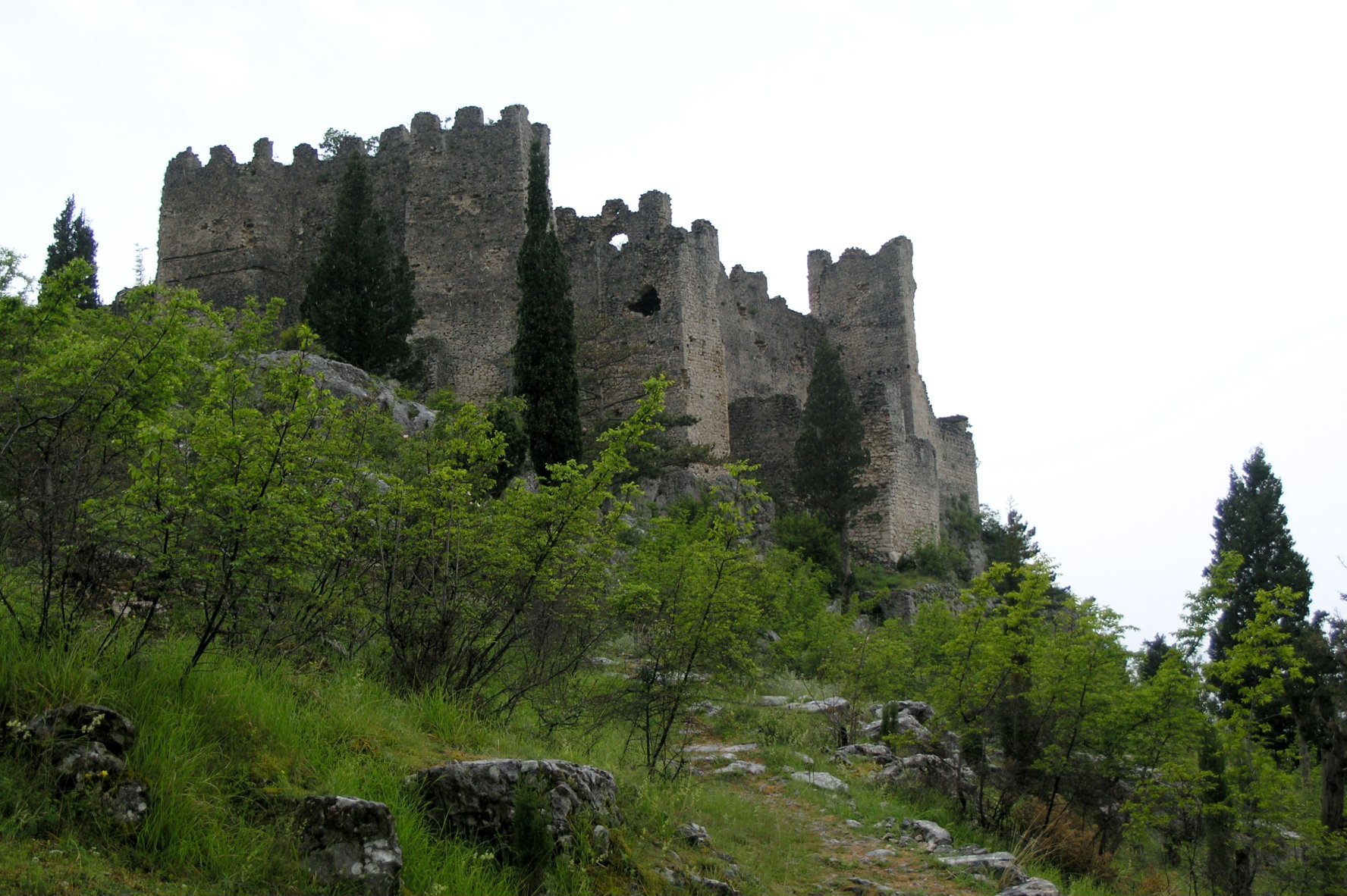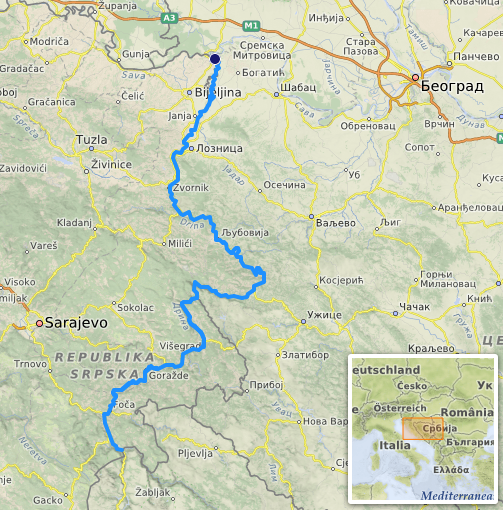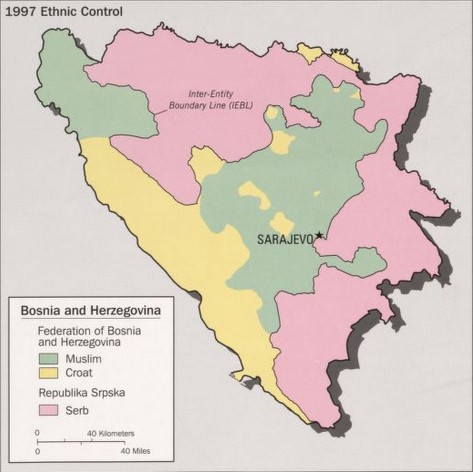|
Goražde
Goražde ( sr-cyrl, Горажде, ) is a city and the administrative center of the Bosnian-Podrinje Canton Goražde of the Federation of Bosnia and Herzegovina, an entity of Bosnia and Herzegovina. It is situated on the banks of the Drina river. As of 2013, the city has a population of 20,897 inhabitants, while the urban centre has 11,806 inhabitants. Location Goražde is situated on the banks of the River Drina in southeastern Bosnia. The city lies at the foot of the eastern slope of the Jahorina mountain at a height of Above mean sea level, above sea level. The settlement is situated on the alluvial terrace in a broad valley, formed by the erosion of the River Drina. The valley borders Biserna to the southeast (701 m (2,300 ft)), Samari to the south (696 m (2,283 ft)), Misjak to the southwest (618 m (2,028 ft)), Gubavica to the west (410 m (1,345 ft)) and Povrsnica to the north (420 m (1,378 ft)). The River Drina flows between these and some other hills. Its valley, which, ... [...More Info...] [...Related Items...] OR: [Wikipedia] [Google] [Baidu] |
Goražde Printing House
The Goražde printing house ( or ) was one of the earliest printing houses among the Serbs,Biggins & Crayne 2000, pp. 85–86 and the first in the territory of present-day Bosnia and Herzegovina (then part of the Ottoman Empire).Benac & Lovrenović 1980, p. 145Kajmaković 1982, pp. 155–58 Established in 1519 in Venice, it was soon relocated to the Serbian Orthodox Church of Saint George in the village of Sopotnica near Goražde,Barać 2008, pp. 41–44 in the Ottoman Sanjak of Herzegovina. It was founded and run by Božidar Ljubavić, also known as Božidar Goraždanin, who was a prominent merchant from Goražde. His son Teodor Ljubavić, a hieromonk of the Mileševa Monastery, managed the work of the printing house. It worked until 1523, producing three books, which are counted among the better accomplishments of early Serb printers.Barać 2008, pp. 46–47 Background After the printing press was invented around 1450 by Johannes Gutenberg in Mainz, Germany, the art of boo ... [...More Info...] [...Related Items...] OR: [Wikipedia] [Google] [Baidu] |
Bosnian-Podrinje Canton Goražde
The Bosnian-Podrinje Canton Goražde ( sh-Latn-Cyrl, Bosansko-podrinjski kanton Goražde, Босанско-подрињски кантон Горажде), until 2001 Goražde-Podrinje Canton ( sh-Latn-Cyrl, Goraždansko-podrinjski kanton, Горажданско-подрињски кантон) is one of ten cantons of the Federation of Bosnia and Herzegovina, an entity in Bosnia and Herzegovina. Demographics 2013 Census Geography It is located in the south-eastern central part of the country, in the region of Upper Drina. The cantonal seat is in Goražde. Municipalities The canton consists of the municipalities of Goražde Goražde ( sr-cyrl, Горажде, ) is a city and the administrative center of the Bosnian-Podrinje Canton Goražde of the Federation of Bosnia and Herzegovina, an entity of Bosnia and Herzegovina. It is situated on the banks of the Drina rive ..., Pale-Prača, Foča-Ustikolina. See also * Drina Banovina * Podrinje * List of heads of the Bosni ... [...More Info...] [...Related Items...] OR: [Wikipedia] [Google] [Baidu] |
Church Of Saint George, Sopotnica
The Church of Saint George, Sopotnica ( sr-cyrl, Црква светог Ђорђа, Сопотница) is a Serbian Orthodox church and the protected National Monument located at the village of Donja Sopotnica in the Municipality of Novo Goražde in eastern Republika Srpska, Bosnia and Herzegovina. The church stands on the left bank of the Drina River, four kilometres from the town of Goražde. The church was built in 1454 and expended in 1455. Its benefactor was Stjepan Vukčić Kosača, while the patron saint of this church is Saint George of Lydda. History and architecture The church is located four kilometres to the north of Goražde, in the village of Donja Sopotnica, on the left bank of the Drina river. The region was, at the time, part of '' Humska zemlja'' that would later come to be known as Herzegovina, after Stjepan's ' Herceg'' title.'' It was built in 1454 by Stjepan Vukčić Kosača, when Goražde was part of a region ruled by him.Lovrenović 2008 ''Herzegovina wa ... [...More Info...] [...Related Items...] OR: [Wikipedia] [Google] [Baidu] |
Stjepan Vukčić Kosača
Stjepan Vukčić Kosača (1404–1466) was a powerful Bosnian Nobility, nobleman who was politically active from 1435 to 1466; the last three decades of Bosnia and Herzegovina in the Middle Ages, Bosnian medieval history. During this period, three List of rulers of Bosnia#Kings and queen (1377–1463), kings acceded to the Bosnian throne: Tvrtko II, Thomas of Bosnia, Thomas ''(Tomaš)'', Stephen Tomašević ''(Stjepan Tomašević)'' and anti-king Radivoj of Bosnia, Radivoj—the older brother of King Thomas—before the country was Ottoman conquest of Bosnia and Herzegovina, conquered by the Ottomans. Stjepan, a son of the Knez (title), ''Knez'' of Drina, Vukac Hranić, and Katarina, whose ancestry is unknown, was probably born in 1404. Stjepan's father held hereditary lands in the Upper Drina region. Stjepan was a member of the Kosača noble family and became its chieftain in 1435 when he succeeded his uncle, Duke Sandalj Hranić Kosača, Sandalj, as Duke of Hum (zemlja ... [...More Info...] [...Related Items...] OR: [Wikipedia] [Google] [Baidu] |
Cantons Of The Federation Of Bosnia And Herzegovina
The ten Canton (country subdivision), cantons of the Federation of Bosnia and Herzegovina, one of the two entities of Bosnia and Herzegovina, political entities of Bosnia and Herzegovina, are its federal units with a high level of autonomy. The cantons were established by the Law on Federal Units (Cantons) on 12 June 1996 as a result of the Washington Agreement of 1994 between the representatives of the Croats of Bosnia and Herzegovina, Bosnian Croats and Bosniaks. Five of the cantons have a Bosniak majority: Una-Sana Canton, Tuzla Canton, Zenica-Doboj Canton, Bosnian-Podrinje Canton Goražde and Sarajevo Canton; three have a Croat majority: Posavina Canton, West Herzegovina Canton and Canton 10, and the two cantons are regarded as ethnically mixed: Central Bosnia Canton and Herzegovina-Neretva Canton. The most populous canton is Tuzla Canton, while Canton 10 is the largest by area. Creation The cantons of the Federation of Bosnia and Herzegovina are a result of an artificial ... [...More Info...] [...Related Items...] OR: [Wikipedia] [Google] [Baidu] |
Drina
The Drina ( sr-Cyrl, Дрина, ) is a long river in the Balkans, which forms a large portion of the border between Bosnia and Herzegovina and Serbia. It is the longest tributary of the Sava River and the longest karst river in the Dinaric Alps which belongs to the Danube River drainage basin. Its name is derived from the Roman name of the river () which in turn is derived from Greek (Ancient Greek: ) which is derived from the native name of Illyrian origin. But, this etymology is not sure.Illyrian languages are poorly documented (only ~50 glosses, mostly personal/place names). - No surviving texts exist, unlike Thracian (which has ~200 inscriptions and loanwords in Greek). - Scholars often label any pre-Slavic Balkan hydronym as "Illyrian" by default, even without proof.We don’t know if Drinus was Illyrian, Thracian, or another lost Paleo-Balkan language. - The safest claim: Drina derives from a ancient Indo-European root (*dhreu-*), preserved in Latin Drinus, but i ... [...More Info...] [...Related Items...] OR: [Wikipedia] [Google] [Baidu] |
List Of Cities In Bosnia And Herzegovina
This is a list of city, cities and towns with over 10,000 inhabitants (or lower if the municipality has over 20,000 inhabitants) in Bosnia and Herzegovina. For the full list of populated places, see List of populated places in Bosnia and Herzegovina. Organization Apart from entities, cantons and municipalities, Bosnia and Herzegovina also has officially designated cities. Official cities have their own mayor and city council, which is a big difference to the municipalities of Bosnia and Herzegovina, which have a municipal council and mayor. Powers of city councils of official cities are between the government of municipalities and government cantons in the Federation of Bosnia and Herzegovina or a government entity in Republika Srpska. There are thirty five official cities in Bosnia and Herzegovina (as of 2024): *Banja Luka *Bijeljina *Bihać *Bosanska Krupa *Brčko *Cazin *Čapljina *Derventa *Doboj *Goražde *Gračanica, Bosnia and Herzegovina, Gračanica *Gradačac *Gradi ... [...More Info...] [...Related Items...] OR: [Wikipedia] [Google] [Baidu] |
Podrinje
Podrinje ( sr-Cyrl, Подриње) is the Slavic name of the Drina river basin, known in English as the Drina Valley. The Drina basin is shared between Bosnia and Herzegovina and Serbia, with majority of its territory being located in Eastern Bosnia, entire Upper Drina course and majority of the Middle course, while the Lower Drina course is shared between two countries, with the river representing border. The part of the Drina basin located in Bosnia and Herzegovina is also called Eastern Bosnia. History Between 1918 and 1922, Podrinje District, with its seat in Šabac, was one of the districts of the Kingdom of Serbs, Croats and Slovenes. The district comprised the north-western part of present-day Šumadija and Western Serbia. Between 1922 and 1929, Podrinje Oblast existed in roughly the same area also with its seat in Šabac. In 1929, a large province of the Kingdom of Yugoslavia known as the Drina Banovina was formed with its capital in Sarajevo. Drina Banovina included ... [...More Info...] [...Related Items...] OR: [Wikipedia] [Google] [Baidu] |
Social Democratic Party (Bosnia And Herzegovina)
The Social Democratic Party of Bosnia and Herzegovina (Bosnian language, Bosnian: ''Socijaldemokratska partija Bosne i Hercegovine'' (SDP BiH) / ''Социјалдемократска партија Босне и Херцеговине''), also simply known as the Social Democratic Party (Socijaldemokratska partija (SDP) / Социјалдемократска партија) is a Social democracy, social-democratic List of political parties in Bosnia and Herzegovina, political party in Bosnia and Herzegovina. It is officially multi-ethnic, although it lost most of its former support among Croats of Bosnia and Herzegovina, Croat and Serbs of Bosnia and Herzegovina, Serb voters in the decade following the 2000 Bosnian parliamentary election, 2000 parliamentary election, when it began to lean more towards Bosniak nationalism, Bosnian populism, and now gathers most of its support from Bosniaks. History Origin The SDP BiH has its roots in the Social Democratic Party of Bosnia–Herz ... [...More Info...] [...Related Items...] OR: [Wikipedia] [Google] [Baidu] |
Federation Of Bosnia And Herzegovina
The Federation of Bosnia and Herzegovina (Serbo-Croatian: ''Federacija Bosne i Hercegovine'' / ''Федерација Босне и Херцеговине'') is one of the two Political divisions of Bosnia and Herzegovina, entities composing Bosnia and Herzegovina, the other being Republika Srpska. The Federation of Bosnia and Herzegovina consists of ten autonomous Cantons of the Federation of Bosnia and Herzegovina, cantons with their own governments and legislatures. The Federation was created by the 1994 Washington Agreement (1994), Washington Agreement, which ended the Croat–Bosniak War within the Bosnian War, and established a constituent assembly that continued its work until October 1996. The Federation has a Sarajevo, capital, Government of the Federation of Bosnia and Herzegovina, government, president, parliament, customs and police departments and two postal systems. It occupies about half of the land of Bosnia and Herzegovina. From 1996 until 2005 it had its own a ... [...More Info...] [...Related Items...] OR: [Wikipedia] [Google] [Baidu] |
Yugoslav Partisans
The Yugoslav Partisans,Serbo-Croatian, Macedonian language, Macedonian, and Slovene language, Slovene: , officially the National Liberation Army and Partisan Detachments of Yugoslavia sh-Latn-Cyrl, Narodnooslobodilačka vojska i partizanski odredi Jugoslavije (NOV i POJ), Народноослободилачка војска и партизански одреди Југославије (НОВ и ПОЈ); ; (often shortened as the National Liberation Army sh-Latn-Cyrl, Narodnooslobodilačka vojska (NOV), Народноослободилачка војска (НОВ); ; ) was the Communist Party of Yugoslavia, communist-led Anti-fascism, anti-fascist resistance to the Axis powers (chiefly Nazi Germany) in occupied Yugoslavia during World War II. Led by Josip Broz Tito, the Partisans are considered to be Europe's most effective anti-Axis powers, Axis Resistance during World War II, resistance movement during World War II. Primarily a Guerrilla warfare, guerrilla force at its ince ... [...More Info...] [...Related Items...] OR: [Wikipedia] [Google] [Baidu] |




